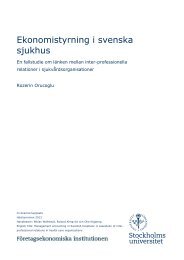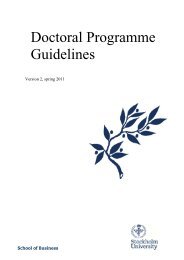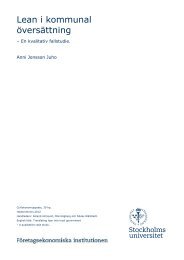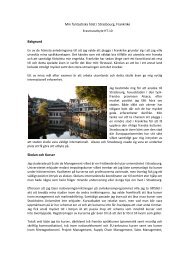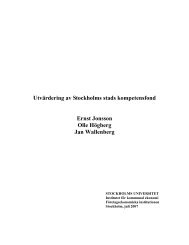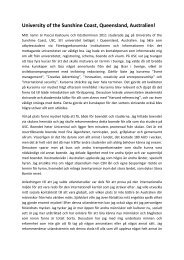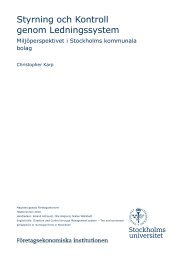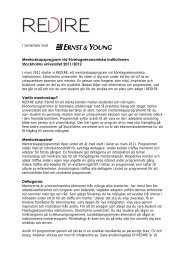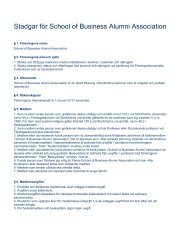Organizational Atmospheres: Foam, Affect and Architecture
Organizational Atmospheres: Foam, Affect and Architecture
Organizational Atmospheres: Foam, Affect and Architecture
Create successful ePaper yourself
Turn your PDF publications into a flip-book with our unique Google optimized e-Paper software.
<strong>Organizational</strong> <strong>Atmospheres</strong><br />
Christian Borch<br />
Architectural <strong>Atmospheres</strong>: <strong>Foam</strong> <strong>and</strong> <strong>Affect</strong><br />
It was mentioned above that Sloterdijk argues that the relation between the<br />
co-isolated foam cells is characterized by imitation dynamics <strong>and</strong> mimetic<br />
infiltration. I will now discuss this relation in more detail <strong>and</strong> associate it<br />
with the discussion of the spatiality <strong>and</strong> architecture of organizational foam.<br />
The starting point of this discussion is Sloterdijk’s own major source of<br />
inspiration, namely, Gabriel Tarde. As demonstrated previously, Tarde<br />
conceives of imitation as a kind of somnambulistic suggestion. Suggestion<br />
has two important implications in Tarde. First, it undermines the notion of<br />
individuality (this was shown above). Second, suggestion emphasizes affect<br />
rather than deliberation <strong>and</strong> conscious choices. Since the social individual,<br />
for Tarde, is akin to a sleepwalker, his or her behaviour is not a result of<br />
purposive action, but rather of ‘semiconscious suggestion’ (Borch, 2007;<br />
Williams, 1982). This means that when Sloterdijk argues that the relation<br />
between foam cells is characterized by imitation, he in fact stresses how crucial<br />
affect is to underst<strong>and</strong>ing foam sociality: the semiconscious imitationsuggestion<br />
addresses rather directly the import of affect, emotions, etc. <strong>and</strong><br />
how these <strong>and</strong> related qualities are transmitted from one cell to others. But<br />
how does this transmission take place more specifically? To answer that<br />
question, Teresa Brennan’s brilliant book on The Transmission of <strong>Affect</strong><br />
(2004) proves helpful. Indeed, I will argue, Brennan offers an important<br />
way of underst<strong>and</strong>ing the link between foam theory’s focus on imitation<br />
<strong>and</strong> the sphereological interest in atmospheres.<br />
Brennan opens the book by relating architecture <strong>and</strong> affect, asking ‘[i]s there<br />
anyone who has not, at least once, walked into a room <strong>and</strong> “felt the atmosphere”?’<br />
(2004: 1). What she claims is that this atmosphere is constituted,<br />
in part at least, by affects. To be more specific, the atmosphere is comprised<br />
by the affective state of those present, <strong>and</strong> this state can be transmitted to<br />
people who enter the room. This is what happens when you feel the atmosphere.<br />
Crucially, Brennan continues:<br />
The transmission of affect, whether it is grief, anxiety, or anger, is social or<br />
psychological in origin. But the transmission is also responsible for bodily<br />
changes; some are brief changes, as in a whiff of the room’s atmosphere, some<br />
longer lasting. In other words, the transmission of affect, if only for an instant,<br />
alters the biochemistry <strong>and</strong> neurology or the subject. The ‘atmosphere’ or the<br />
environment literally gets into the individual. (Brennan, 2004: 1)<br />
It is important to stress that no biological reductionism is at play here. Quite<br />
the contrary, the argument is that social <strong>and</strong> psychological factors generate<br />
specific biological reactions, not the other way around. 7 Further, it is interesting<br />
to note that Brennan’s discussion is aimed in part as a critique of<br />
the notion of self-contained individuality. According to Brennan, it is too<br />
often taken for granted that emotions can go ‘no farther than the skin’ of<br />
the individual person (2004: 2). But, she demonstrates, this assumption<br />
is undermined by a plentitude of studies <strong>and</strong>, indeed, by the argument<br />
on the transmission of affect. This critical perspective on self-contained<br />
233<br />
Downloaded from<br />
org.sagepub.com at Stockholms Universitet on March 30, 2011



